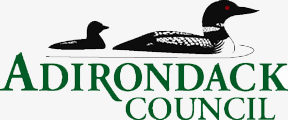
Adirondack Winter Road Maintenance Conference Concludes
 |
 |
Adirondack Winter Road Maintenance Conference Concludes:
Participants Want Clean Water, Safe Winter Roads
FOR IMMEDIATE RELEASE, Thursday, September 18, 2014
For more information:
Lee Keet, AdkAction.org, 518-261-6608
John Sheehan, Adirondack Council, 518-432-1770 (o),518-441-1340 (c)
Daniel Kelting, Paul Smith’s College, 518-327-6213
PAUL SMITHS, N.Y. – Road salt is accumulating in the watersheds of the Adirondack Park and salt levels in Adirondack streams are higher than in urban areas, according to new research unveiled at a winter road maintenance conference here.
However, an official from Colorado told the group that his state has made significant changes in its road maintenance programs that reduce road salt damage to the environment, while keeping roads safe in similar extreme winter conditions.
In response, local officials in attendance said immediate action should be taken to reduce the use of road salt. In addition, a group of volunteers agreed to form a new Road Salt Alternative Working Group to study the total costs of alternative winter road maintenance techniques and their impact on roads, bridges and water quality.
The working group will also examine rights-of-way in the Adirondacks to see where natural mechanisms like sunlight and passive filtering could be used to assist with snow and ice removal, while better protecting local waters.
The group will identify funding sources for further studies of ground water contamination and salt toxicity, for public education, and for training of state and municipal employees. A follow-up meeting will be scheduled soon.
“We made a lot of progress,” said Lee Keet of AdkAction.org, a co-sponsor of the conference. “Nearly 80 town, county, and state leaders met with representatives of the leading environmental and research organizations. We all agreed to work cooperatively toward solutions that keep roads safe, while protecting water from contamination.”
“Our research clearly shows that road salt is accumulating in our watersheds and that salt levels in Adirondack streams can exceed those encountered in urban areas,” said Dan Kelting, Executive Director of the Paul Smith’s College Adirondack Watershed Institute. “These results strongly suggest that our groundwater is being contaminated with road salt, which is a threat to human health, and further our aquatic ecosystems may be experiencing toxicity.”
“Everyone agreed that we already know enough about the damage road salt is doing to take action to reduce our use of it,” said Rocci Aguirre, Conservation Director of the Adirondack Council. “Water quality, human health, wildlife, roadside trees, roads, bridges and guiderails are all suffering damage. We can stop that damage, but we want to make sure we keep our roads safe too.”
More information is needed on the toxicity of alternative chemicals; the impact current salting has had on ground water; and, the implications of any chemical use, including road salt (sodium chloride), on human health.
Participants also agreed that we lack sufficient data on the cost of current practices, notably the destruction of vehicles and infrastructure that salt creates and the comparative cost of alternative strategies, including abrasives such as sand.
The conference included presentations by:
- Department of Transportation (DOT) officials from New York and David Weider from the DOT in Colorado, each offering different views on the use of de-icers;
- Research teams from the Cary Institute for Ecosystem Studies (Millbrook) and the Adirondack Watershed Institute (Paul Smith’s College);
- Local officials who helped create an experimental porous-pavement project next to Lake George as an example of one non-chemical approach to keeping roads clear of surface water and ice;
- A leading legal expert who reviewed the liability issues associated with changing current methods and techniques in an attempt to reduce salt use and increase safety.
Specific actions proposed by the participants include improving communications between the various state, county, and municipal agencies involved in winter road maintenance. A new look at road design was listed as an imperative, particularly seeking the "low hanging fruit" that can be implemented at low cost such as better management of run-off, passive filters, and where possible opening up the tree canopy to let the sun do more of the de-icing job.
A five-year plan to adopt these new technologies was suggested, including additional test runs to try techniques used elsewhere, e.g., the use of liquid magnesium chloride in place of sodium chloride, the technique used successfully by Colorado.
“The conference was a great success,” said William C. Janeway, Executive Director of the Adirondack Council. “We are excited about the broad interest in this topic across state agencies, local government, scientists, park residents and environmental organizations. We can reduce the use of salt while keeping roads safe and protecting clean water, infrastructure and public health.”
The conference was co-sponsored by AdkAction.org, the Adirondack Council and Paul Smith's College.




